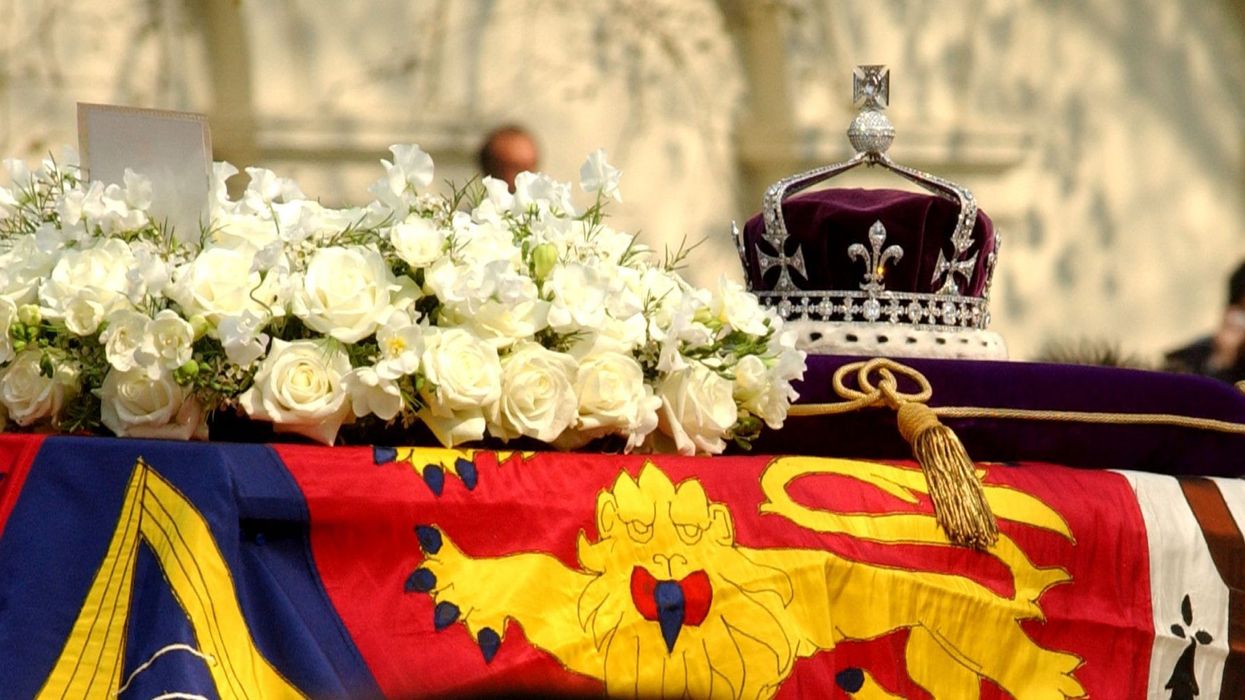I (FELICITY) am apparently descended from a lineage of Sikhs, whose legendary kingdom once spanned Punjab, Peshawar and Kashmir.
In the 19th century, its 12-year-old maharaja was coerced into surrendering the empire’s most treasured possession to Viscount Henry Hardinge, signifying a British victory over the Lahore Darbar. It is in this manner that the Koh-i-Noor diamond – whose name in Persian means “The Mountain of Light” – found itself the centrepiece of the Victorian crown jewels.
Fahrid, on the other hand, is related to the Barakzai Kings of Afghanistan through a 19th century princess who married a Sufi mystic. Her own ancestors had cherished the diamond, passing it down the generations as a coveted heirloom after acquiring it from a rival dynasty of Persians.
Can we - two barristers - lay claim to the most famous diamond in the world?
History shows the Koh-i-Noor is connected with Mughal India, Afsharid Persia, Durrani Khorasan and Sikh Punjab - regions whose territories lie in the modern-day states of India, Iran, Afghanistan and Pakistan.
The original owner - the likely slave who discovered it thousands of years ago - and the location of such an incredible find are ultimately unknown.
At least, morally, Britain is faced with addressing its colonial past today, a process which may result in the return of some cultural heritage to Africa, the Indigenous peoples of Australia and the Indian sub-continent - as well as numerous other erstwhile ‘pink bits’ on the map.
The genealogy of the Koh-i-Noor , in particular, gives rise to questions of restitution, repatriation and/or reparations, which as legal questions may be difficult to answer.
The Collections Trust, based in the UK but working internationally, helps museums work with the information that connects collections and audiences. Their standards and advice are used around the world to make museum collections accessible.
They have made it plain that: “Heritage organisations seek to ensure that they hold collections documentation demonstrating that objects in their collections have good provenance and have not, at some point in their history, been acquired as a result of spoliation and/or illicit trade. Occasionally, either as the result of an organisation’s research or as the result of a claim made by an individual or community, objects in public collections are returned to previous owners”.

Logically, for the Koh-i-Noor, held in the Tower of London, the question of return is a live one - especially now that the future Queen has decided not to wear it.
Cultural loss has not been defined as a separate category of claim in civil law. From the literature, it appears to be a source of damage upon which an injured party may claim in a separate action established under a law.
So, the first question may be whether the claim is for the value of the rock or its meaning to the peoples of the relevant region - or both. It may be hard to quantify, but the sums are huge, even though the diamond was cut down before landing in the Coronation Crown.
In our view, the legal position for those responsible for the diamond may fall into three categories: Restitution, Repatriation and Reparations (forms of restorative justice). Restitution is where cultural objects are returned to an individual or a community. It is now over a century since the young maharaja was coerced into signing his heritage away under the Treaty of Lahore. The temporal issue of limitation on a claim is ever-vexing in law, although some academics and commentators frustrated by the application of the intertemporal rule have sought to identify methods of circumventing its perhaps disproportionately harsh consequences.
In an ongoing case on historic slavery in the Cook Islands, we are considering several avenues by which to circumvent the intertemporal rule, including attempts to extend the slavery prohibition further back in time. Alternatives include rejecting the application of intertemporal law entirely, focusing on the current harms sustained, extending the initial period of harm, and lastly an argument based on state consent. In the context of the Koh-i-Noor, it may be that only the issue of state consent will be applicable, and it does not look as though Britain is looking to consent to its return somewhere or anywhere anytime soon.

Even if the limitation issue could be overcome, the next question concerns standing – who can claim the diamond? Certainly, the Treaty appropriating the Koh-i-Noor for Britain suggests the young maharajah and his community have a legitimate claim - but what of those before him from whom the diamond was looted and sometimes apparently consensually transferred for centuries with a limited degree of record-keeping and where claims and counter-claims as to provenance are difficult to make out with certainty today. Should the diamond be restored to the Punjabis, and if so which ones? Is it my potential Sikh cousins in the bejewelled cities of Amritsar and Kapurthala in northern India? Or Fahrid’s brethren in Pakistan, whose Sufi shrine in Lahore pays testament to the region’s historic penchant for migration and mysticism?
Evidently, the chances of any sort of clarity for a legal judgment on restitution may well be remote.
What then of repatriation? This is the process by which cultural objects are returned to a nation or state at the request of a government. If the contours of a claim by the people of Punjab are unclear, one can only imagine the difficulties concerning claims put forth by modern-day nation-state. These entities did not exist, in their current iteration, at the time of the most appropriation, and it is therefore potentially anachronistic and atavistic to frame claims to the diamond in the language of 21st century statehood.
By the same token, issues of geography and legitimacy arise. Some might opine that the people of Afghanistan or Iran, where the jewel resided for centuries, might have a valid claim to ownership. We can imagine the objection and outcry were there to be any suggestion that the Koh-i-Noor might fall into the hands of the Taliban, whose iconoclasm and contempt for historical antiquities has been a matter of public knowledge since the destruction by dynamite of the Buddhas of Bamiyan in 2001.
Although the Koh-i-Noor was plainly a ‘spoil’ of war appropriated by the British colonialists, very quickly we can start to see that the situation is very different from the case of Mrs Altman who famously arbitrated the return of her family portrait of Klimt’s The Kiss, where the US Supreme Court - equally famously, at least amongst lawyers - held that the relevant legislation applied retrospectively in the case of Nazi loot.
Nonetheless, without the need for a campaigning woman like Mrs Altman, there are green shoots of solutions for cultural loss. Post-Colonialism makes it necessary to see if we can achieve non-conflict related solutions through reparations.
In Australia, there are the burgeoning signs of apology through a national sorry and The Human Rights and Equal Opportunity Commission Report Bringing Them Home Report of the National Inquiry into the Separation of Aboriginal and Torres Strait Islander Children from Their Families, which discussed cultural loss in the context of the stolen generations.
On land, culture and language, the report stated the purpose of an apology and restoration “is to re-establish, to the extent possible, the situation that existed prior to the perpetration of gross violations of human rights.”
The sacking of India’s treasures and massacre of its people, as well as the division of families by partition, are known and ripe for an apology and some meaningful memorialisation. The question is how to approach this using restorative methods, not conflict - the controversy over the Koh-i-Noor may be a good place to start.
The Report of the Special Rapporteur on the promotion of truth, justice, reparation & guarantees of non-recurrence in 2021 examined the design and application of measures in the area of truth, justice, reparation, memorialisation, and guarantees of non-recurrence to address gross violations of human rights and international humanitarian law committed in colonial contexts. The conclusion was that reparations, whether individual or collective, should aim to be comprehensive and include recognition of the harm caused and the responsibilities involved, the dissemination of information in this regard, the issuance of public apologies, the restitution of cultural heritage, and compensation.
There are cases where settlements have been made for historic slavery, but not for the removal of minerals.
Interestingly in Germany, there has been an apology for colonial genocide in Namibia, but the official statements about Germany’s debt to Namibia did not account for diamond mining at all – one can start to see that it may be expensive to account for past wrongs that enriched some countries and devasted others.
What then might be a non-contentious solution? Maybe there is a precedent we can take from the case of King Tutankhamun – robbed from his grave but now travelling the world for everyone to see: that too with accompanying accurate history and no doubt complex insurance.
We are not sure whether the Koh-i-Noor will go on tour anytime soon, but perhaps we can hope that its conflicted past is properly told - maybe in a dedicated facility away from the tower, with accompanying displays tracing its monumental journey from Hindu temples to the Mughals’ Peacock Throne, from Persian Shahs to Afghan Kings, and finally from the Sikh Maharajas to the British Crown.
We would be happy to negotiate that outcome, and then we would be able to queue to see our history if it succeeds.
Professor Felicity Gerry KC is an international KC at Libertas Chambers, London and Crockett Chambers, Melbourne, largely defending in serious and complex criminal trials and appeals, often with an international element. She also comments in the media on international legal issues, especially related to international crimes, terrorism and homicide and corporate responsibility for human rights abuses.
Fahrid Chishty is an advocate with Libertas Chambers and practices across its core specialisations, with particular focus on serious and organised crime, fraud and financial crime and public international law. Beyond his court practice, Fahrid has also developed an extensive advisory practice and has been instructed by business magnates, politicians and members of foreign royalty.












